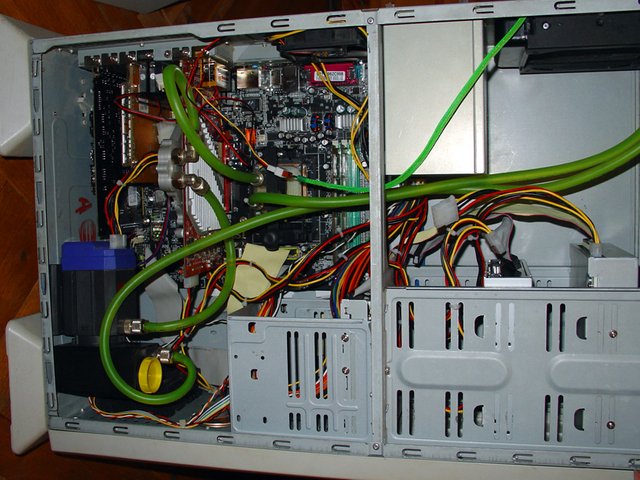
I was going through some old photos and found some interesting ones back from more than 12-13 years when I actually built my first water-cooled computer. The photo above shows the hardware inside my computer back from early 2004 when overclocking and water cooling was nothing as common or as easy as it is nowadays. Not to mention that the hardware was not as pretty looking and shiny and covered with RGB lights and such all over to make it attractive like the trend that has been going on for the last couple of years. Back at that time good hardware and more exotic components were hard to find, more expensive and you often had to apply some serious DIY skills to make what you want.
So what is inside the case that you see on the photo? Well, even the computer cases were nothing like that the latest trends are - they were pretty boring looking white and most were not very big and flexible as they are today. Even having a big case like the one of the photo was not very common thing, though you still needed a computer case like that in order to fit a water cooling solution inside (that is actually a small 120mm size radiator). The system had a water cooled GeForce FX 5900 Ultra GPU by Gainward that had a custom water block and backplate fitted on the video card. I have extender the standard water cooling loop with a CPU block for the Socket 754 AMD Athlon 64 CPU that the system used. The Athlon 64 CPU was a real breakthrough for AMD at that point in time and it was really giving Intel some hard time, though since them AMD has been struggling to catch up to the strong competition that Intel put after the release of the first Core processors.
That water cooling setup, half ready, was my first venture into water cooling for computers and pretty much ever since that all my desktop computer systems at home are using custom water cooling setups as I have mentioned in previous posts. When I look back now how things have changed in the PC industry in the last 12 or so years it really brings back some nice memories from the times when you had to do a lot of things yourself as you just could not buy them with money. This was a time when I even went to some overclocking tournaments to show off some nice hardware setups and overclocking skills... now things like that don't look impressive at all, in fact they even seem pretty plain and common...
If you have a question or want to add something, then please leave a comment below.
Did you like what you have just read? Check my other posts on steemit @cryptos
If you like what I'm doing for Steem and on Steemit you can support me as a Witness
Man this makes me appreciate the simplicity of today's systems especially the ready out of the box ones.
Downvoting a post can decrease pending rewards and make it less visible. Common reasons:
Submit
I considered water cooling on my PC to make it quieter when I built it. I actually tried a passive cooler first (NoFan CR-80EH), but unfortunately that just didn't work. Maybe mine was faulty, but I ended up getting a big one with a quiet fan. I don't overclock or use a big graphics card and so watercooling seemed like overkill. The PC is quiet enough generally. Ideally it should be silent. Mind you, some old computers we used at work were pretty noisy. They have gotten better over time
Downvoting a post can decrease pending rewards and make it less visible. Common reasons:
Submit
Not a big fan of passive cooling solutions myself, these require a lot of surface area to give away heat and usually the operating temperatures remain higher than I would ideally want them to be...
For a regular PC with an average or low-end hardware and no gaming GPU there is not much point in going for water cooling setup, you can find good silent coolers. If you are building a high-power system for gaming or for work however going for water cooling can help you make it silent even under constant heavy load. Water cooling is also very helpful when overclocking the CPU or the video card as you can generally squeeze more performance without getting too high operating temperatures.
Downvoting a post can decrease pending rewards and make it less visible. Common reasons:
Submit